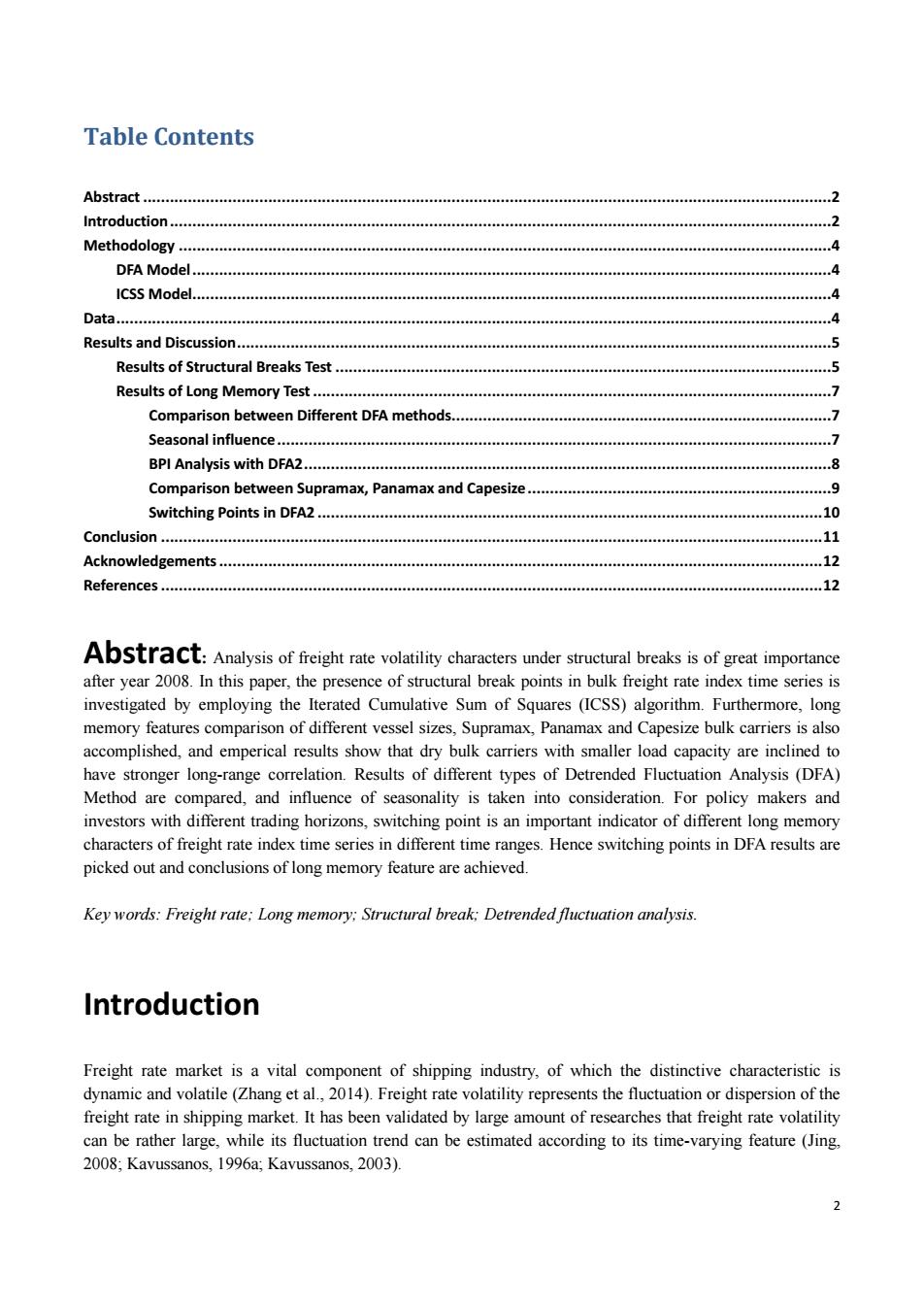正在加载图片...

Table Contents Abstract..… …2 Introduction........ .2 Methodology........ ….4 DFA Model. .4 ICSS Model.… 4 Datg..................... 4 Results and Discussion................ 5 Results of Structural Breaks Test........... 5 Results of Long Memory Test........... 7 Comparison between Different DFA methods.. 7 Seasonal influence.............. 7 BPI Analysis with DFA2.... 8 Comparison between Supramax,Panamax and 9 Switching Points in DFA2...... .10 Conclusion........... 40.11 Acknowledgements........ 12 AStCt:Analysis of freight rate volatility characters under structural breaks is of great importance after year 2008.In this paper,the presence of structural break points in bulk freight rate index time series is investigated by employing the Iterated Cumulative Sum of Squares (ICSS)algorithm.Furthermore,long memory features comparison of different vessel sizes,Supramax,Panamax and Capesize bulk carriers is also accomplished,and emperical results show that dry bulk carriers with smaller load capacity are inclined to have stronger long-range correlation.Results of different types of Detrended Fluctuation Analysis (DFA) Method are compared,and influence of seasonality is taken into consideration.For policy makers and investors with different trading horizons,switching point is an important indicator of different long memory characters of freight rate index time series in different time ranges.Hence switching points in DFA results are picked out and conclusions of long memory feature are achieved. Key words:Freight rate;Long memory:Structural break;Detrended fluctuation analysis. Introduction Freight rate market is a vital component of shipping industry,of which the distinctive characteristic is dynamic and volatile(Zhang et al.,2014).Freight rate volatility represents the fluctuation or dispersion of the freight rate in shipping market.It has been validated by large amount of researches that freight rate volatility can be rather large,while its fluctuation trend can be estimated according to its time-varying feature (Jing, 2008;Kavussanos,1996a;Kavussanos,2003).2 Table Contents Abstract ..........................................................................................................................................................2 Introduction....................................................................................................................................................2 Methodology ..................................................................................................................................................4 DFA Model...............................................................................................................................................4 ICSS Model...............................................................................................................................................4 Data................................................................................................................................................................4 Results and Discussion.....................................................................................................................................5 Results of Structural Breaks Test ...............................................................................................................5 Results of Long Memory Test....................................................................................................................7 Comparison between Different DFA methods.....................................................................................7 Seasonal influence............................................................................................................................7 BPI Analysis with DFA2......................................................................................................................8 Comparison between Supramax, Panamax and Capesize....................................................................9 Switching Points in DFA2 .................................................................................................................10 Conclusion ....................................................................................................................................................11 Acknowledgements.......................................................................................................................................12 References....................................................................................................................................................12 Abstract: Analysis of freight rate volatility characters under structural breaks is of great importance after year 2008. In this paper, the presence of structural break points in bulk freight rate index time series is investigated by employing the Iterated Cumulative Sum of Squares (ICSS) algorithm. Furthermore, long memory features comparison of different vessel sizes, Supramax, Panamax and Capesize bulk carriers is also accomplished, and emperical results show that dry bulk carriers with smaller load capacity are inclined to have stronger long-range correlation. Results of different types of Detrended Fluctuation Analysis (DFA) Method are compared, and influence of seasonality is taken into consideration. For policy makers and investors with different trading horizons, switching point is an important indicator of different long memory characters of freight rate index time series in different time ranges. Hence switching points in DFA results are picked out and conclusions of long memory feature are achieved. Key words: Freight rate; Long memory; Structural break; Detrended fluctuation analysis. Introduction Freight rate market is a vital component of shipping industry, of which the distinctive characteristic is dynamic and volatile (Zhang et al., 2014). Freight rate volatility represents the fluctuation or dispersion of the freight rate in shipping market. It has been validated by large amount of researches that freight rate volatility can be rather large, while its fluctuation trend can be estimated according to its time-varying feature (Jing, 2008; Kavussanos, 1996a; Kavussanos, 2003)